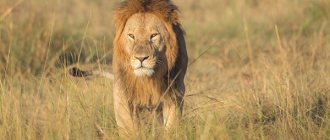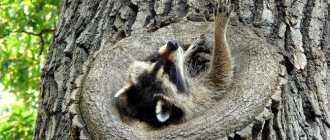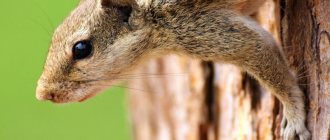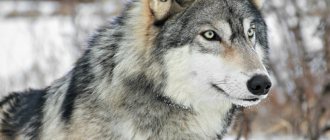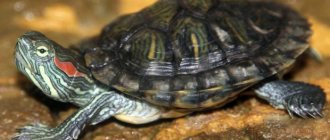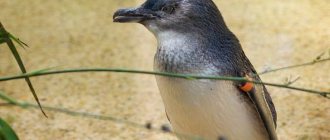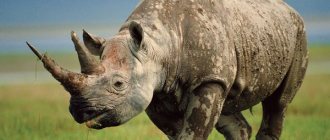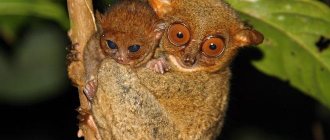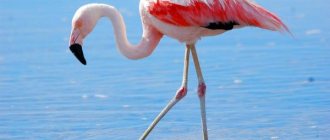Jaguar is a cat of the Panther genus, one of the largest among its brothers. This is the only Panther living in the Americas, and the third largest large cat after the tiger and lion, the most powerful feline in the Western Hemisphere. Its current range extends through Mexico and much of Central America to southern Paraguay and northern Argentina. Apart from a known and possibly breeding population in Arizona, the predator has been almost completely extirpated in the United States since the early 1900s.
The jaguar is an endangered species and its populations are gradually declining. Threats to the species include habitat loss and community fragmentation. While international trade in them or their parts is prohibited, the cat is still regularly killed by humans, especially due to conflicts with South American ranchers and farmers.
History of the discovery of the species
Panthera onca originated in the Old World 2.5–3 million years before the present and migrated to North America about 2 million years ago. During much of the Pleistocene, its range extended much further north than it does today (reaching Nebraska and Oregon in the United States, and southern England and the Netherlands in Europe).
Historically, the predator has been found from the southwestern United States to southern Argentina, but its current distribution is much smaller. This dramatic reduction in range over the last million or so years has led to what some today call the Jaguar a relict population. The decline in range since the mid-Pleistocene was accompanied by a 15-20% decrease in animal body mass and a change in limb proportions, so that extant animals had shorter metapodials, perhaps in response to hunting in closed habitats.
The morphology and behavior of other large predators have evolved to allow them to optimally kill a limited number of prey species within a certain range of their prey weights, which also corresponds to prey age classes. Jaguars are solitary hunters, so their prey preferences would be expected to be similar to leopards Panthera pardus, given that the two species are considered ecological counterparts in the New and Old Worlds, respectively. These animals clearly differ from leopards, if only in that they are approximately twice as heavy with shorter, stronger limb bones and relatively wide front paws, which are comparable in size to the lion's Panthera leo.
Moreover, Panthera onca are more lion-like than leopard-like in that they have both absolutely and relatively large upper canines and lateral incisors. In fact, these cats appear to have the strongest teeth of any living feline relative to body size.
These morphological characteristics indicate specialization in strength relative to mass, suggesting that jaguars must kill larger prey than leopards.
Across their range, Jaguars exhibit up to 100% variation in body mass, and this likely influenced their hunting decisions, as the smallest forms are more leopard-like (in the size of their prey).
Prey is fundamental to the existence of large predators, but in the case of the Jaguar, it is unclear from existing reviews what the primary prey is. The current prevailing view is that these animals are opportunistic predators whose diet simply reflects the available prey community in their hunting grounds. This is not surprising given their wide distribution and adaptability to their environment. The cat's diet is varied, with at least 85 species listed as prey, which range from cattle weighing over 200 kg to small rodents. Among the victims are also arboreal primates, ocelots, sea and river turtles and fish, crocodiles and their eggs, and dolphins.
The diversity of aquatic prey reflects the Jaguar's habitat use and swimming ability. Most of these victims are killed earlier, but predators also hunt for corpses (up to 17 days after death). Despite this variety of prey and their apparent strength, Jaguars tend to kill animals slightly smaller than themselves (predator:prey ratio 1 to 0.6–0.9 if livestock is excluded).
Observers describe a hunting technique often used by Jaguars to kill large ungulates, in which they jump onto the back or side of a buffalo, pulling its head, unbalancing it, and causing it to fall to the ground - often causing broken cervical vertebrae.
The name "jaguar" comes from their hunting technique, it has roots in one of the Tupi-Guarani languages, in this dialect the name of the predator means "a wild beast that overcomes its prey in a bundle."
Other hunting methods used by Jaguars include using their front paws to strike small prey species (such as capybaras), tackling, and using a single bite on the back of the head to puncture. These behavioral data suggest that the predator has mechanisms to successfully kill large prey.
Medium and large animals are critical hunting resources for Jaguars, varying depending on habitat, levels of competitors, and prey availability. This study aimed to determine which jaguar resources are critical by identifying the species' preferred prey, and to examine the impact of the Pleistocene extinction event on the animal's predatory ecology. Scientists have conducted extensive research into human-wildlife conflict resulting from the killing of Jaguars in retaliation for livestock.
Population and species status
Photo: Jaguar animal
Nowadays, one can observe sad statistics that indicate that the jaguar population is continuously declining. In many places where they were previously found, predators have completely disappeared. It is a pity that even the lord of the jungle himself cannot contain the destructive human force from which many animals suffer.
Mr. Cat recommends: description, characteristics, area
Adult Jaguars are apex predators, meaning that they exist at the very top of their food chain and are not preyed upon in their natural habitat.
This is a keystone species as it controls the levels of herbivorous and non-predatory mammal populations and maintains the structural integrity of the forest system.
However, an accurate determination of the impact of Panthera onca on ecosystems is difficult, because the parameters must also be compared across territories where this species is not present, and, in addition, across its modern zones of residence, taking into account the influence of human activities. Medium-sized cats are thought to experience population expansion in the absence of stronger competitors, and it has been suggested that this has a cascading negative effect. However, field observations prove that these may be natural fluctuations and the increase in the number of populations may not be maintained.
Jaguars belong to the genus of big cats Panthera and the complete taxonometry or scientific classification of Panthera onca is as follows - they are vertebrate mammalian carnivores belonging to the suborder Felidae, family Cats, subfamily Felidae, genus Panthera, species Jaguar.
The scientific name Panthera onca, which is known as the binomial name of the Jaguar, is Latin and is the same from both biological and zoological points of view.
This spotted cat most closely resembles a leopard in physical features, although it is generally larger and more robustly built, and its behavior and characteristics are closer to those of a tiger.
The preferred habitat of Panthera onca is dense tropical forests, but the animal can be located in various other biotopic landscapes. It usually selects areas where water is present and is known, along with the tiger, as a cat that loves to swim.
The raptor's base coat is typically yellowish-brown in color, but can vary to brownish-red and black. The cat's fur is dotted with rosettes, which helps it camouflage in the jungle. The spots vary among individual populations and are never repeated: rosette markings may contain at least one, and more often several, points, and their shape is different. The head and neck markings are usually solid, also on the tail, here they can merge to form a stripe. The lower belly, throat, outer surface of the legs and lower lobes of the sides are white.
The jaguar resembles the leopard of Africa and Asia, but the latter lacks a black central spot in its markings. Along the midline of the wild cat's back is a series of long black spots that may merge into stripes. The base color of the jaguar varies greatly from white to black. Although brown and black jaguars appear solid, the spots are always visible, although sometimes faintly.
Jaguars are also larger and more powerful than leopards. The male, which is usually larger than the female, reaches a length of 1.7-2.7 meters, including a tail of 0.6-0.9 m, with a height at the withers of 0.7-0.8 m. The animal weighs from 100 to 160 kg . South American individuals are the most outstanding in size.
The jaguar (Panthera onca) is the largest cat in the Americas. There is no doubt that the most elusive, impressive and impressive mammal in the Costa Rican rainforest is the Jaguar.
The word "jaguar" itself comes from the Indian Guarani word "jaguara", meaning "one who kills from one border." Native Americans across the spectrum revered these apex predators for their strength, cunning, and beauty. In many cultures they are treated as god-like entities, and their presence is woven into many mythologies. Their images adorn the walls of many temples, carvings, paintings and ceremonial masks throughout America.
This beast symbolizes fear, respect and reverence.
Jaguars are now critically endangered across their once great territory and have been wiped out from many areas where they once thrived. Encounters with these magnificent animals are rare and often fleeting.
Jaguars are known to kill bulls weighing up to 400 kg and are considered a major pest for livestock farmers throughout Latin America. It's hard to imagine such a powerful creature hiding in the forest, living among us.
The Jaguar's range once ran from the Grand Canyon or perhaps Colorado in the United States down through Argentina. However, the cat was hunted for its beautiful fur. While it is possible that some cats remain in Texas, Arizona and New Mexico, significant populations exist only in Mexico and Central and South America. Jaguars living in protected areas have a high chance of rebuilding their communities, notable examples being the Ca'an Biosphere Reserve in Mexico, the Cockscomb Wildlife Sanctuary in Belize, and Manu National Parks in Peru and Xingu National Parks in Brazil. However, jaguars are gradually disappearing from much of their range.
Although jaguars prefer forested areas near water, they also live in bushes, wetlands, grasslands and savannas.
How is a jaguar different from a leopard and a cheetah?
Leopards and jaguars are very similar in appearance, and both belong to the genus Panthera (big cats). The two main differences between them are their size and habitat. Leopards live exclusively in the Old World - Africa, Asia and Europe. Jaguars live in North, South and Central America. Jaguars are much larger than leopards, more squat and massive, their legs and tail are shorter, and their jaws are more powerful. Both species hunt from ambush and lead a similar lifestyle, so they are not easy to distinguish.
Cheetahs are very different from both jaguars and leopards. Cheetahs belong to the genus of small cats, have a slender, lean, elongated body, and chase their prey while running. The cheetah is easily distinguished by its two black tear stripes on its face from the corners of its eyes to its mouth, its small head and long, thin legs. Unlike leopards and jaguars, cheetahs cannot retract their claws and do not climb trees well.
Color also differs among animals. The jaguar has a rich, bright yellow fur color and large black spots in the form of a rosette with a spot in the middle. The leopard has large ring-shaped spots all over its body, and its belly is noticeably lighter in color. The cheetah has small solid black spots all over its fur.
Black Jaguar: photo and description of the animal
Melanistic individuals of Panthera onca are often called black panthers, but, like all forms of polymorphism known to science, they do not form a separate species.
Black isomorphs are rarer than common spotted ones and scientists estimate that approximately 6% of them are found in South American Jaguars.
In the Mexican subspecies, the first melanistic individuals were discovered only at the beginning of this century.
Some evidence suggests that the melanistic allele is dominant and is maintained by natural selection. The black form may be an example of heterozygous advantage. Breeding them in captivity is not yet the final solution on this issue.
Melanism in the jaguar is caused by a dominant allele, while in the leopard (Panthera pardus) it is caused by a recessive allele. A close examination of the coloration of these black cats reveals that the typical markings are still present, but are hidden due to the excess of the black pigment melanin, giving an effect similar to the image of printed silk. This color is called the “ghost stripe.”
Melanistic and non-melanistic animals can be littermates. It is thought that melanism may confer a selective advantage under certain conditions, as it is more common in densely forested areas where light levels are lower. Recently, preliminary studies have also suggested that melanism may be associated with beneficial mutations in the immune system. Since the melanism allele is dominant in Jaguars, black individuals can produce charcoal or spotted cubs, but a pair of spotted predators can only reproduce kittens of their own kind.
Individuals with two copies of the allele are darker (the black background color is denser) than individuals with one copy, whose background color may be steel rather than black.
The black jaguar has long been considered a separate species by the indigenous inhabitants of the Old and New Worlds.
Thus, the English naturalist Hudson wrote: “The jaguar is a beautiful creature, the main color of the fur is a rich golden-red tan, abundantly marked with black rings, containing one or two small spots. This is a typical coloration, and varies little in the temperate regions; in the hot region the Indians recognize three distinct varieties, which they regard as distinct species—the described, smaller jaguar, less aquatic in its habits, and marked with spots rather than rings; and thirdly, the black variety. They reason that their terrible "black tiger" is simply melancholic, like the black leopard of the Old World and the wild black rabbit. They consider him quite different and claim that he is larger and much more dangerous than the spotted jaguar, which they know by his call; that it belongs to the Terra Firma and not to the water side; finally, that black couples always live with similar ones, and that their young are always black.”
Extremely rare albinos, sometimes called white panthers, are also found among Jaguars, as well as other big cats. As usual in wild albinos, selection maintains the frequency close to the mutation rate.
Appearance and features
Photo: Jaguar animal
The appearance of the jaguar is truly irresistible. One can simply envy his stature, grace and beautiful fur coat. This is the only cat from the panther genus that inhabits America, its size and appearance are quite impressive. At the withers, a jaguar can reach a height of 80 cm. Its muscular body can be from 120 to 180 cm long, not counting the tail, which sometimes extends up to 90 cm. The weight of jaguars varies from 68 to 136 kg.
Females are much smaller than males. There is an interesting case where a real heavyweight in this cat kingdom was recorded - a jaguar, weighing as much as 158 kg! It has been noticed that predators living in open areas are larger in size compared to those living in wooded areas. Most likely, this is influenced by the abundance of food, which is much more abundant in the steppe zones, because entire herds of ungulates graze there.
The jaguar's head is large and strong with powerful squared jaws. The jaguar's body is slender and lean. The ears are small and rounded. The eyes are truly catlike, predatory, the gaze is strong-willed and slightly arrogant. The animal’s limbs are strong and squat, the muscles on them are well developed, their grip and power are immediately noticeable. Jaguar runners are also excellent, these predators can reach speeds of up to 100 km per hour, and they attack so lightning and swiftly that the victim does not even have time to come to his senses.
The magnificent skin of a jaguar is a delight due to its amazing colors. The predator's fur is not long, but very thick and pleasant to the touch.
The general background shade of the body can be:
- beige;
- sandy;
- reddish;
- brown.
The entire body is everywhere covered with dark spots, which in different individuals can be smaller or larger, have a solid or rosette color. In some specimens the pattern is presented in the form of rings. The entire face of the jaguar is strewn with small dark specks that stand out clearly against the overall lighter background. The animal's ears are dark in color with a light spot in the middle. From below, the body of the jaguar is light gray, almost white.
Interestingly, jaguars are also black, they are not so rare, this is due to the presence of the panther gene in the predator. Such specimens are called melanists. They have spots on their fur coat, but against the general charcoal background they are not visible at all. More often, such cubs are born to individuals inhabiting forest areas. There was an amazing case at the Odessa Zoo when a family of jaguars in a litter had a pair of cubs that were of normal color, and a pair that were completely black. These are the metamorphoses of nature!
Features of behavior
The jaguar is most often called a solitary hunter.
Its behavior has a great influence on the survival and lifestyle of other predatory cats in overlapping habitat areas.
If we compare the Jaguar and the puma, whose habitats often overlap, the former often chooses larger prey, usually heavier than 22 kg, and the puma is smaller, usually from 2 to 22 kg.
The level of social activity of the jaguar is not very different from other large cats. So, this animal never competes with cubs and teenagers.
Adult males, as a rule, meet only with the female and companions (although in rare cases selective collectivization is observed) and determine spacious hunting territories for themselves.
The sizes of women's hunting grounds range from 20 to 45 square meters. km. and it is possible to suppress them among themselves, but the females try not to collide with each other.
Male ranges cover almost twice the area (up to 85 sq. km.), They vary in size more often due to the types of prey and biotopes inhabited there. Scratches, physiological secretions, and friction on tree trunks are used by animals to mark boundaries.
Like other big cats, Jaguars are capable of roaring (the male more powerfully) and do so to warn territorial competitors and mating individuals, with intense male-male combat observed in the wild. The roar of the beast is similar to a prolonged coughing fit, but predators can also meow and snort.
Conflicts between males occur most often due to territorial disputes. The fact is that the range of a male individual can cover the zones of several female ones, and the male does not tolerate the invasion of other adult competitors.
The jaguar is more often characterized as a nocturnal predator, but to be more precise, it is a crepuscular animal (peak activity occurs at dawn and also falls at dusk).
Both males and females hunt, but since the former's hunting grounds are much larger than those of women, they have to move much more. These energetic cats spend more than half a day moving around hunting grounds.
The elusive nature of Jaguars and the almost complete inaccessibility of large parts of their habitats in the wild make this animal almost elusive and little studied today.
Character
Like most cats, jaguars lead a solitary lifestyle, the only exception being females who live with grown cubs. Otherwise, predators meet with each other only to procreate, and each adult has its own territory. The territory of a female averages from 25 to 40 square kilometers, and may overlap with the territories of other predators. The territory of males is on average 2 times larger, and the territories of males do not intersect with each other. At the same time, the hunting grounds of several females may be located on the male’s territory.
Like other big cats except the snow leopard, jaguars are capable of growling. Their growl resembles a prolonged cough, which is interspersed with meows and grunts. Conflicts between individuals are usually associated with territorial disputes. A male jaguar will allow 2-3 females into his territory, but will not tolerate another male.
Jaguars are considered to be nocturnal hunters, but their favorite hunting time is dusk, before sunset and shortly before dawn. If there is prey, the predator is able to hunt during the day. The animal is very active and spends 50-60% of its time in motion. Jaguars attack people very rarely, and generally do not view people as food. This is due to the fact that jaguars practically do not hunt primates. However, with the reduction of the animals' natural habitat and food supply, animals have no choice and attacks on people are becoming more frequent.
Diet
Throughout their range, Jaguars prefer prey weighing 45-85 kg, with the most preferred species being the capybara and the giant anteater. Other commonly used prey include wild boar, common caiman, collared peccary, nine-banded armadillo and coati, while agoutis, other carnivores, primates, the common possum and tapir are generally avoided by the predator.
Jaguars are unusual among large cats in that they have no prey preference for ungulates and are, in fact, omnivores. Some predators still prey on livestock.
While the Jaguar often uses the choking and deep throat-biting techniques common among Panthera, it sometimes employs a unique method of killing among cats - its fangs penetrate directly through the temporal bones in the skull between the ears of the victim (especially the capybara), piercing the prey's brain.
This may be a way of adapting to the "cracking" of turtle shells, since after the extinction at the end of the Pleistocene, armored reptiles such as tortillas would have formed a rich prey base for the predator. Biting the skull is used, in particular, by the Jaguar in mammals.
In fights with reptiles such as caiman, the animal often jumps onto the back of the prey and ruptures the cervical vertebrae, immobilizing the target.
When hunting sea turtles, including the huge leatherback sea turtle, which weighs on average about 385 kg, the Jaguar often attacks them on the sandbanks where they are preparing to lay eggs. The predator bites through the brain, often even decapitating the prey, before dragging it off to a secluded spot to eat it.
When hunting horses, bison, buffalo, or antelope, the Jaguar can jump on their back, put one paw on the muzzle and the other on the back of the head, and then turn, dislocating the neck and cutting the vertebrae.
Jaguars prefer not to catch up with the prey, but to wait for it in ambush; the animal has the patience to sit motionless for hours, so that, after waiting for the moment, it can finish off the prey with one swift leap.
The animal prefers to eat the carcass not during the hunt, but in its secluded special place. He has many such temporary rookeries or dens throughout his hunting territory.
This is a real gourmet, which first eats the neck and chest part of the victim, then tears out and eats the heart and lungs, and only then moves on to the limbs and sides.
The daily food requirement of a predator weighing 34 kg in the extremely low weight range of the species is estimated at 1.4 kg per day.
For captive animals in the 50-60 kg weight range, more than 2 kg of meat per day is recommended. In the wild, consumption is naturally more chaotic, Jaguars expend considerable energy in preying on and killing prey, and they can consume up to 25 kg of meat in one sitting, after which a period of fasting usually ensues.
There is evidence from naturalists that despite their carnivorous nature, Jaguars periodically eat the roots of wild forest plants, for example, such as Banisteriopsis caapi, a vine growing in the jungles of South America, from which locals prepare a hallucinogenic drink.
According to scientists, the jaguar diet includes more than 110 wild species, ranging in size from rabbits (1 kg) to lowland tapirs (130 kg).
Nutrition
Jaguars are strictly carnivorous mammals. They have a rich diet, over 85 species have been recorded as jaguar food. Preferred prey are large animals such as peccaries, tapirs and members of the deer family. They also hunt caimans, turtles, snakes, porcupines, capybaras, fish, birds and other animals. Jaguars usually attack prey from a secluded place. They make a direct bite to the neck and then strangle the victim or kill it instantly by piercing the back of the skull with their fangs. Their powerful jaws and fangs allow them to kill thick-skinned reptiles and bite through turtle shells. Then, the jaguars drag their prey to a secluded place and enjoy the food.
Puberty and reproduction
Females of the predator become sexually mature closer to two years, and males reach the ability to fertilize by three or four years.
In their natural habitat, Jaguars can mate throughout the year, which, given the abundance of prey, can significantly increase the number of offspring.
The reproductive period of a female Jaguar is almost ten years.
Female estrus occurs within 5-18 days of a complete 37-39 day cycle, and females advertise fertility with scent marks and loud calling calls.
Females are very active during the mating season, but after pregnancy occurs the couple separates from the “wedding” pack. Although in the future all parental responsibilities are performed only by the female.
Pregnancy lasts from 90 to 105 days, usually in a litter there are no more than four kittens, with an average of two cubs. Females deliberately remove males from fathering duties, since they often eat the cubs.
Jaguars are born with their eyes closed, gaining the ability to see no earlier than two weeks later. Their mother feeds them milk until they are three to four months old, and then they go with her to the hunting territory to learn their first survival skills in the jungle.
The young live with their mother until at least two years of age before leaving her to find their own hunting territory. Although some specimens become completely independent by the end of the first year of life.
The average life expectancy of Jaguars in their natural habitats is 11-17 years, in captivity it is much longer, up to 25 years. These are perhaps the longest-living wild cats.
Communication and perception
Jaguars primarily communicate through vocalizations. It increases in tone or power and differs depending on the individual making the sound, whether male, female, or female in heat. Males have more powerful vocalizations than females. During estrus, females call late at night and at dawn. The male's response to the female's call is more hoarse and guttural. Hunters sometimes imitate the sounds of a female to attract a male. Jaguars mark territory with vocalizations, mark trees, and defecate on vegetation.
Captivity
Jaguar populations are now rapidly declining. The animal is considered endangered, as defined by the International Union for Conservation of Nature and Natural Resources, which means that the species could face complete extinction in the near future.
The main risks to the Jaguar are deforestation throughout its habitat, increased competition for food with humans, poaching, hurricanes in the northern parts of its range, and the behavior of ranchers, who often kill the cat in areas where it preys on livestock. The predator is adapted to hunting prey and therefore perceives livestock as a significant part of the food menu.
However, Jaguar populations most likely increased when herds of cattle were first introduced to South America, as the animals appreciated the benefits of the new food supply. The willingness to farm and raise livestock prompted ranchers to hire hunters and jaguars were often killed on the farms.
The jaguar is regulated as an Appendix I species and all international trade in the animal or its parts is prohibited.
All hunting of Jaguars is prohibited in Argentina, Belize, Colombia, French Guiana, Honduras, Nicaragua, Panama, Paraguay, Suriname, the United States (where they are listed as endangered under the Endangered Species Act), Uruguay and Venezuela.
Jaguar hunting is restricted to "problem animal" status in Brazil, Costa Rica, Guatemala, Mexico and Peru, while trophy hunting is still permitted in Bolivia.
The species has no legal protection in Ecuador or Guyana. Current Jaguar conservation efforts often focus on educating ranchers and promoting ecotourism.
The jaguar is generally defined as an umbrella species whose range and habitat requirements are broad enough that if it is protected, numerous other smaller range species will also be conserved.
Such "umbrella" species serve as "mobile links" at the landscape scale, in the case of the Jaguar through predation. This way, conservation organizations can focus on providing viable, connected habitat for this cat, knowing that other species will also benefit.
Jaguar conservation
Half a century ago, scientists determined that these predatory mammals were on the verge of extinction, and therefore were listed in the International Red Book. In many countries, rallies were held in support of wildlife, and propaganda was also carried out with the aim of humanity refusing to wear clothes made of natural fur. To be fair, the demand for jaguar skins has fallen. The hunt has not become so active, but despite this, it continues to this day. Some countries have not completely banned jaguar hunting, meaning the animals are being killed, albeit in small numbers.
Important point! In addition to direct physical destruction, humans cause great damage to animals through habitat destruction, reducing natural habitats through cutting down tropical forests. As a result of such activities, many animals that represent the predator’s diet die. To feed future offspring, females give birth to fewer and fewer babies.
The last few decades have seen huge national parks created in many countries on the South American continent to protect jaguars. At the international level, laws have been passed prohibiting the trade of these, and other, animals. As life shows, such measures were not enough, and the population of jaguars on our Planet is steadily declining. This is very alarming and very sad, since human life is to blame for everything. It thoughtlessly introduces itself into living nature, upsetting its balance, which leads to the death of many animals, as well as the destruction of huge forests.
For many indigenous peoples of America, this animal is personified with strength, courage, grace, speed and nobility. Their altars are decorated with these animals carved from stone. Many Indian leaders were dressed in the skin of jaguars, which personified their power. Strength and beauty are concepts that fully characterize this amazing predator.
Subspecies
There are three main subspecies of jaguars:
1. Panthera onca onca – Venezuela, although the Amazon is also included. 2. Panthera onca hernandesii – (Mexican jaguar): Northern Mexico. The Mexican jaguar includes the following 4 subspecies: – Panthera onca centralis (Central American jaguar): from El Salvador to Colombia. – Panthera onca. arizonensis (Arizona jaguar): Southern Arizona to Sonora, Mexico. – Panthera onca. veraecrucis: Central Texas to southeastern Mexico. – Panthera onca goldmani: from Yucatan to Belize and Guatemala. 3. Panthera onca palustris (largest subspecies, reaching a weight of about 135 kg): Pantanal region of Mato Grosso and Muto Grosso do Sul, Brazil along the Paraguay River and northeastern Argentina.
What do jaguars eat in the wild?
Recommended by topic
Fox Panda Lynx
Of course, jaguars eat meat, as true predators should. By the way, unlike many furry relatives who occasionally supplement their diet with plant foods, American cats are indifferent to vegetables and fruits, and will definitely not feast on cereals and herbs.
For large representatives of the cat family, the most preferred prey is ungulates. But in the natural habitats of jaguars, only a few species of deer are found, and even those are mainly found on the plains and pampas. So the spotted predators had to expand the list of their gastronomic preferences, turning their attention to other inhabitants of the tropical jungle.
This caiman is destined to become a jaguar's lunch
The basis of the jaguar menu is:
- Tapirs;
- Capybaras;
- Bakers;
- Black tailed deer;
- Monkey;
- Anteaters;
- Armadillos;
- Otters;
- Caymans;
- Anacondas.
If a jaguar fails to catch large game, it can satisfy its hunger with smaller animals. The extensive list of victims of these cats includes iguanas, rabbits, foxes and various birds. The diet of predators also includes turtles and their eggs. They also love fish, which is found in abundance in American rivers. Well, in the event of a catastrophic shortage of food, the jaguar will not disdain to snack on rodents and even frogs.
Having caught the prey, the jaguar begins to eat, starting to eat the carcass from the head, crushing the skull with its powerful jaws. The cat consumes large prey in 2 doses and does not return to the scraps, leaving them for other animals to eat. What’s also interesting is that jaguars eat exclusively fresh meat and will never pick up carrion.
Jaguar hunting methods
Jaguars have chosen impenetrable forests as their habitat, and among the dense vegetation there is no space for long runs. Therefore, spotted predators do not look for prey, but lie in wait for it in ambush. After all, why exhaust yourself with a grueling marathon, chasing agile monkeys and peccaries, if you can set a trap and wait for a potential meal to fall into your clutches?
Jaguar in ambush
Favorite ambush sites for jaguars are paths leading to reservoirs and lush thickets of bushes on river banks. The spotted skin of cats serves them as an excellent camouflage, making them practically unnoticed against the backdrop of tall grasses. Jaguars have limitless patience and endurance, and can sit motionless in their shelter for hours. As soon as the intended target is dangerously close to the predator, the jaguar quickly attacks, overtaking the victim in one jump.
If the object of the hunt discovered a hiding animal and rushed away headlong, the cat will not pursue the fleeing animal. The owner of the jungle will calmly remain in ambush and wait for the next prey, which sooner or later will appear at the watering hole.
These predators also hunt in trees with no less skill. Hidden among the dense foliage, jaguars quickly grab monkeys that carelessly approach a deadly trap. And spotted cats managed to conquer the water element. Jaguars are excellent swimmers and divers, thanks to which they can catch not only fish, but also such dangerous inhabitants of South American rivers as caimans.
Poll: Many people consider jaguars to be the most beautiful felines. Do you agree with this opinion?
Certainly! Jaguars are simply magnificent, especially panthers!
25%
Yes, comparing jaguars with other cats, I think that they really are the most beautiful.
50%
I find it difficult to answer. As for me, all wild cats are beautiful in their own way.
0%
No, I don't agree. For me, the most beautiful cats are tigers and lynxes.
25%
Voted: 4
Habitat
The jaguar is the only representative of the big cat family living on the American continent. The range of spotted cats extends from the southern United States to the central lands of the South American continent.
Dense and humid jungle is an ideal habitat for a jaguar.
If you draw the geographical line of the jaguar territory from north to south, it looks like this:
- American state of Arizona;
- Mexico;
- Belize;
- Guatemala;
- Honduras;
- Nicaragua;
- Costa Rica;
- Panama;
- Colombia;
- Venezuela;
- Suriname;
- Guyana;
- French Guiana;
- Ecuador;
- Brazil;
- Peru;
- Bolivia;
- Paraguay;
- Argentina;
- Uruguay.
Jaguars have chosen the tropics and difficult jungles as their habitat, where there is enough shelter for them. Huge cats love to settle near water bodies and in wetlands, densely overgrown with bushes and mangroves. Predators avoid arid open plains and high mountain plateaus; they prefer the humid climate that reigns in shaded forests. In search of food, jaguars can travel along the ocean coasts and climb to a height of up to 200 meters above sea level, but they do not stay there for long.
The list of countries in which jaguars are found is, of course, impressive, but in fact the situation with their natural habitats is quite critical. Previously, their natural range covered an area of 20 million km2, but has now been reduced by more than half. And the reason lies in human activity. Deforestation and drainage of swamps for farming plantations forced jaguars to leave their homes and go into the impenetrable jungle. But every year there are fewer and fewer pristine places where human hands cannot reach, and it is likely that in ten years these predators will remain only in protected areas.
